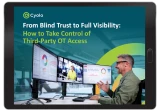Table of Contents
What is OWASP?
OWASP (Open Web Application Security Project) is a non-profit, online community that is dedicated to improving web application security. OWASP operates as an open community that creates, shares and participates in articles, events, videos, discussions, methodologies, tools, technologies, documentation, open source projects, and more. Their resources are available to everyone on the OWASP website.
The OWASP Top 10
One of the most notable community projects created by OWASP is the “OWASP Top 10”. OWASP Top 10 is a guiding document of web application risks, and is considered an industry consensus for awareness. Every few years, the top ten web application risks are ranked, together with in-depth explanations and remediation suggestions.
Why is OWASP Top 10 Important?
The OWASP top 10 can help engineering and security leaders as well as developers check to make sure their applications do not pose any risk to the organization. The list is an actionable checklist, and can also be used as a benchmark for organizations to see where they stand, security-wise. With so many new security tools and vulnerabilities, OWASP top 10 is a simple plan to follow, with an immediate impact.
Top 10 Web Application Security Risks, by OWASP
Injection - SQL, NoSQL, OS and LDAP injections. Read more here.
Broken Authentication - Incorrect implementation of authentication methods
Sensitive Data Exposure - Sensitive data that is not properly protected
XML External Entities - Disclosure of internal files by external entities in XML processors
Broken Access Control - Access control to data and functions that isn’t enforced
Security Misconfiguration - Configurations that are outdated, incomplete or misconfigured
Cross-Site Scripting (XSS) - Flaws due to data not being validated
Insecure Deserialization - Flaws leading to remote code execution, injection attacks, and more.
Using Components with Known Vulnerabilities - Running vulnerable components that have application-level privileges.
Insufficient Logging and Monitoring - Lack of auditing and incident response tools.
How Zero Trust Can Protect Against the OWASP Top 10
Zero trust is a security architecture and model that authenticates and verifies every user and device before providing them with access to network applications or assets. The purpose of zero trust is to eliminate transitive trust and to continuously authenticate identities before providing access, instead of granting access based on inherited parameters like network origin or domain membership. In addition, zero trust cloaks the network to prevent internal user visibility.
Implementing the zero-trust security model can help prevent attacks based on the OWASP Top 10. First and foremost, when the zero-trust framework is enforced, attackers will have no visibility into potential OWASP applicative vulnerabilities. While perimeter-based solutions provide users with visibility into the network and sometimes even tunnel users in, as in the case with VPNs, zero trust hides applications and network components from users until they are authenticated. Thus, adversaries cannot know where vulnerabilities may lie.
In addition, zero trust enables adding security controls, which act as an additional security layer to reduce the attack surface and protect from OWASP security risks. These include:
WAFs (Web Application Firewalls): WAFs filter, monitor and block traffic to applications. They can help protect from injections (1), XML external entities (4), cross-site scripting XSS (7), insecure deserialization (8) and using vulnerable components (9).
SSO: SSO, an authentication method that enables logging in with one set of credentials, helps prevent authentication errors (2)
RBAC (Role-based access control): RBAC restricts system access to unauthorized users and helps prevent broken access control (5). Coupled with virtual patching, it also prevents sensitive data exposure (3) and security misconfiguration (6)
Auditing and logging: Zero trust monitors, audits and records user actions in the network. This provides visibility, enables tracing suspicious actions and remediating issues to prevent insufficient logging and monitoring (10).
Implement Zero-Trust Access with Cyolo PRO
Cyolo PRO (Privileged Remote Operations) is a remote access solution built on the principles of zero trust. In full accordance with zero trust, Cyolo allows customers to keep their keys, passwords, policies, and other secrets inside the organization and never has access to this sensitive data, eliminating a point of accidental exposure. And unlike many legacy access solutions, Cyolo PRO does not just protect the initial point of access but secures the full connection from end-to-end with connectivity and oversight controls such as session monitoring and recording, the ability to block risky actions, and much more.
To learn more about how Cyolo PRO can help defend your organization against a multitude of threats, including the OWASP Top 10, schedule a commitment-free demo.

Subscribe to Our Newsletter







